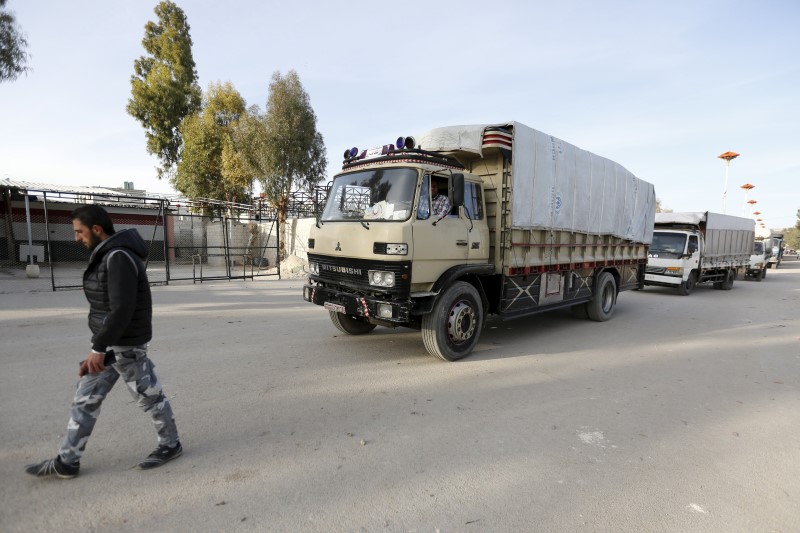BEIRUT (Reuters) - Trucks carrying humanitarian aid began to enter four of five besieged areas of Syria scheduled for deliveries on Wednesday in a U.N.-backed deal to deliver help to thousands of trapped residents, an aid agency source and conflict monitor said.
The Syrian government has approved access to seven besieged areas, the United Nations said after crisis talks in Damascus on Tuesday, a week ahead of a planned resumption of peace negotiations between Syria's warring parties.
The United Nations estimates there are 486,700 people in around 15 besieged areas of Syria, and 4.6 million people in hard-to-reach areas. In some, starvation deaths and severe malnutrition have been reported.
Aid convoys have begun to enter Madaya and Mouadamiya al-Sham near Damascus which have been under siege by government forces, and the villages of al-Foua and Kefraya in Idlib province which are surrounded by rebel fighters.
Aid has not yet begun to enter Zabadani, also near Damascus and surrounded by government forces, conflict monitor the Syrian Observatory for Human Rights said.
Nine aid trucks crossed a checkpoint to enter Mouadamiya al-Sham earlier on Wednesday, a Syrian Arab Red Crescent source told Reuters.
There have been several aid deliveries to Madaya and Zabadani and to al-Foua and Kefraya this year, but each has to be carefully synchronized between the warring sides so that convoys enter simultaneously.
The Syrian Red Crescent is coordinating with the U.N. on the deliveries which include wheat and high-energy foods, with medical teams being sent to some areas.
The U.N. has demanded unhindered access to all besieged areas of the country, where it says hundreds of thousands of people are trapped by fighting and deliberate blockades by various warring sides.
In Madaya, near the border with Lebanon, dozens have starved to death after months of siege by government forces and their allies.
In the city of Deir al-Zor in eastern Syria, parts of which are under siege by Islamic State militants, unverified reports have said up to 20 people have died of starvation.
Deir al-Zor was one of the seven areas to which the aid convoys were expected to head within the next few days, the U.N. said.
Yacoub El Hillo, U.N. Humanitarian and Resident Coordinator in Syria, said aid operations must continue beyond recent efforts to restart peace talks, but a solution to the root of the problem must also be found.
UNRELENTING FIGHTING
Syria's opposition says it will not negotiate with Damascus until sieges imposed by government forces and their allies have been lifted - one of many issues that led to a suspension of the peace talks in Geneva earlier this month.
Talks are scheduled to resume on Feb. 25, but fighting and air strikes continue unabated throughout the country, where 250,000 people have been killed in five years of war.
In the town immediately next to Mouadamiya, Daraya, the Syrian army and allied forces continue a major offensive to take back the rural suburbs of Damascus still in rebel hands.
In Deraa city, south of Damascus, jets believed to be Russian pounded insurgent positions on Wednesday near a now-closed rebel-held border crossing with Jordan. The attacks appeared aimed at cutting rebel supply lines.

A fighter from al-Tawhid al-Janub Brigade, part of the Southern Front rebel alliance, said the bombing of the old quarter of Deraa city, which has been in rebel hands for nearly three years and whose residents have fled since the start of the conflict, was the heaviest in over two years. The army controls the rest of the city.